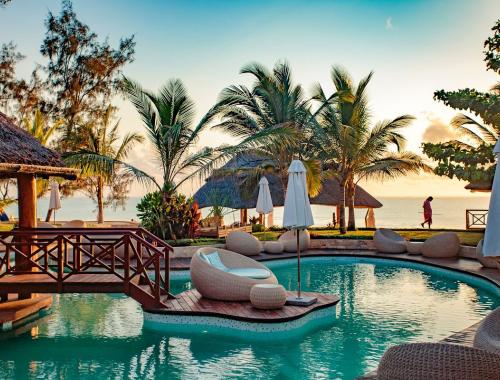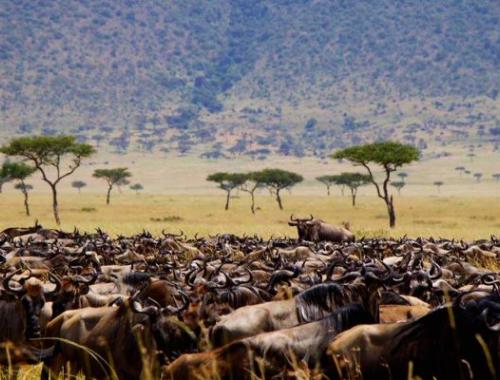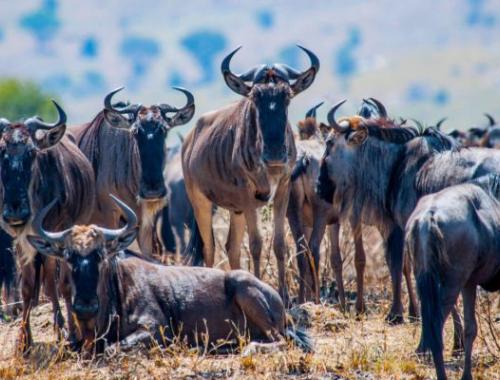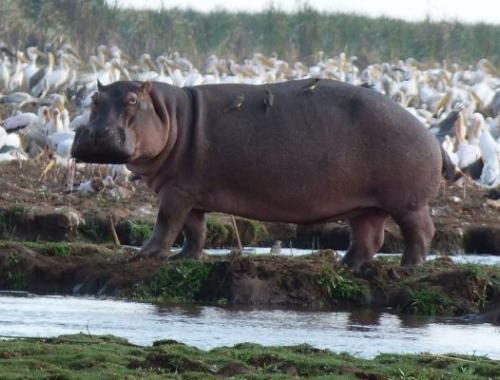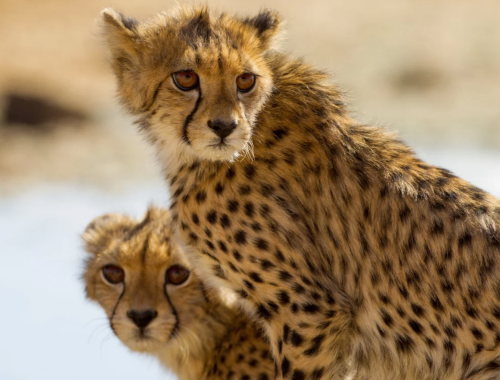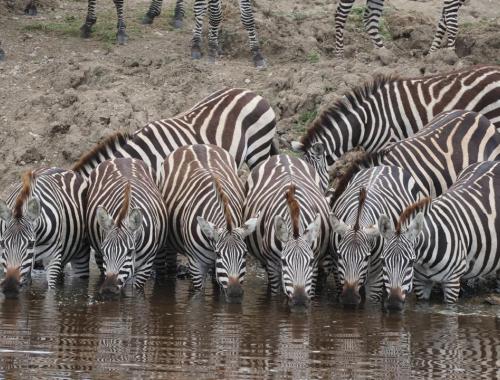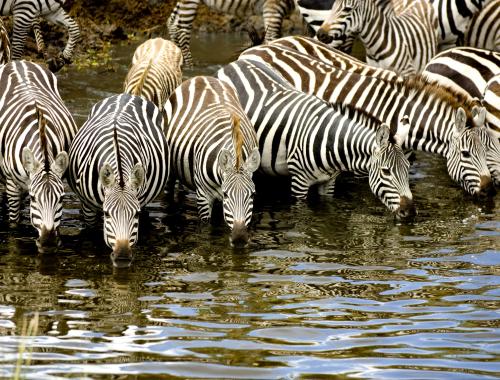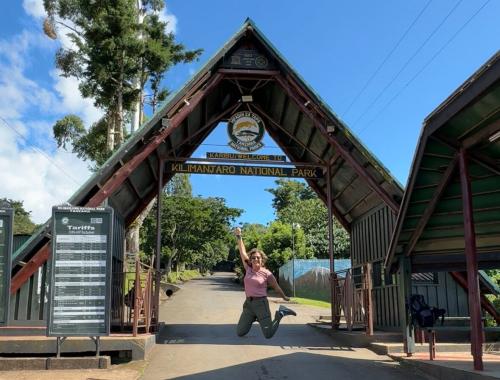Lake Manyara National Park
Lake Manyara is a beautiful lake found in northern Tanzania. It sits at the bottom of a big steep hill called the Great Rift Valley. The lake is part of Lake Manyara National Park, which is a protected area full of animals and birds. The lake is not very deep and has salty water. Many flamingos come here, and sometimes the whole lake looks pink because of them. You can also see elephants, giraffes, zebras, hippos, and even lions that like to climb trees — which is very rare.
Around the lake, there are green forests, open plains, and warm springs. It is a peaceful and special place where nature is well protected. Many people visit to enjoy the wildlife and the beautiful views.
Quick Facts about Lake Manyara
🗺️ Location: Northern Tanzania, at the base of the Great Rift Valley escarpment
🌊 Type: Shallow, alkaline (salty) lake
🏞️ Part of: Lake Manyara National Park
🦩 Famous for: Large flocks of pink flamingos
🦁 Unique wildlife: Tree-climbing lions (rare behavior)
🐘 Other animals: Elephants, hippos, giraffes, zebras, baboons
🐦 Bird species: Over 400 kinds, great for birdwatching
🌳 Ecosystems: Groundwater forest, savanna, and hot springs
📅 Best time to visit: June to October (dry season for wildlife viewing)
🚗 Distance from Arusha: About 2 hours by car
History of the Lake Manyara
Lake Manyara has a long history that includes both nature and people. It was formed a very long time ago by movements in the earth that created the Great Rift Valley. Water collected in this low area and formed the shallow, salty lake we see today. Over time, many animals and birds came to live around the lake. It became known for its large groups of flamingos, elephants, and even lions that climb trees. Because of its rich wildlife, the area was turned into Lake Manyara National Park in 1960 to protect nature.
People have also lived near the lake for many years. Local tribes like the Maasai and Mbugwe have used the land for farming and keeping animals. The name "Manyara" comes from a Maasai word for a plant used to build fences for cattle.
Today, Lake Manyara is a special place where nature and local culture come together.
Accessing Lake Manyara
Lake Manyara National Park is easily accessible by both road and air, making it a convenient destination for travelers exploring Tanzania's Northern Safari Circuit.
Pristine Trails
🚗 By Road
- From Arusha: The park is approximately 126 km (78 miles) southwest of Arusha, a journey that takes about 1.5 to 2 hours via a well-maintained tarmac road.
- From Mto wa Mbu: This nearby town serves as a gateway to the park. Travelers can take public transportation to Mto wa Mbu and then hire a vehicle to reach the park entrance.
✈️ By Air
- Kilimanjaro International Airport (JRO): Located about 46 km from Arusha, this airport handles international flights.
🗓️ Best Time to Visit
- Dry Season (June to October): Ideal for wildlife viewing as animals congregate around water sources.
Wikipedia - Wet Season (November to May): Best for birdwatching, especially to see migratory species.
Why is lake Manyara Special?
Lake Manyara is a special place because it has many things that make it different and beautiful.
🌍 Beautiful Location
Lake Manyara sits below a big cliff called the Great Rift Valley. This makes the area very scenic, with hills, forests, open land, and the lake all together in one place.
🦁 Tree-Climbing Lions
One of the most special things about Lake Manyara is its lions. Unlike most lions, the ones here like to climb trees and rest on branches. This is very rare and only seen in a few places in the world.
🐘 Many Elephants
The park is home to many elephants. People often see them walking near the road or drinking water near the lake. They are one of the main reasons tourists love visiting.
🦩 Lots of Birds and Flamingos
Lake Manyara is great for birdwatching. The lake’s salty water attracts thousands of pink flamingos and more than 400 other bird types. It’s a perfect place for people who enjoy watching birds.
🌳 Different Environments
Even though the park is small, it has many types of landscapes: green forests with water flowing underground, wide grasslands, hot springs, and the lake itself. These different areas support many animals and plants.
👨👩👧 Local People and Culture
People like the Maasai and Mbugwe live near the park. They have used the land for farming and raising animals for many years. The name “Manyara” comes from the Maasai language and means a type of plant used for fencing.
🚗 Easy to Reach
Lake Manyara is only about 2 hours from Arusha by car. It is part of Tanzania’s famous safari route, so many visitors stop here on the way to other parks like Serengeti and Ngorongoro.
✅ Protected Area
The area became a national park in 1960. This means the animals and nature here are protected so that people can continue to enjoy and learn from them in the future.
Activities in Manyara National Park
Manyara National Park, officially known as Lake Manyara National Park, is a scenic and biodiverse park located in northern Tanzania. It's famous for its diverse landscapes, tree-climbing lions, and flocks of flamingos. Here are some popular activities you can enjoy in the park:
🦁 Wildlife Viewing (Game Drives)
- See animals such as elephants, giraffes, hippos, buffaloes, wildebeest, zebras, and the park's unique tree-climbing lions.
- Best done in the early morning or late afternoon when animals are most active.
🐦 Bird Watching
Over 400 bird species, including:
- Flamingos on Lake Manyara
- Pelicans, storks, and herons
- Raptors and forest birds
Great for bird lovers, especially during the wet season.
🌄 Canoeing (Seasonal)
- When water levels permit, you can canoe on Lake Manyara.
- A peaceful way to view hippos, birds, and the lake's surroundings.
🚶🏽 Nature Walks and Forest Hikes
- Guided walks through groundwater forests and around hot springs.
- Learn about flora, insects, birds, and the smaller ecosystems often missed on game drives.
🏞️ Maji Moto (Hot Springs) Visit
- Located in the southern part of the park.
- Natural hot springs with beautiful scenery and a picnic spot.
🚲 Cycling Tours (Outside the Park)
- Some lodges and operators offer cycling tours along the Rift Valley escarpment and near local villages.
👣 Cultural Tours
Visit nearby Mto wa Mbu village for an immersive cultural experience:
- Interact with local tribes (e.g., Maasai)
- Try traditional food
- Explore local markets and art centers
🌌 Night Game Drives (Special Permit Needed)
- A rare chance to see nocturnal wildlife like civets, porcupines, and genets.
Lake Manyara National Park has a tropical climate with rainy weather from November to May and dry weather from June to October. It’s warmer in the dry season and cooler in the rainy season.

